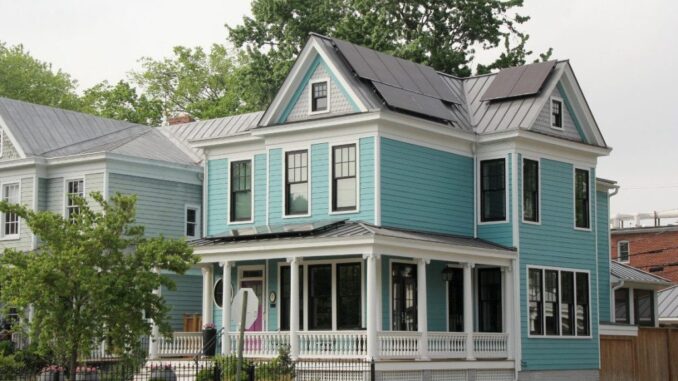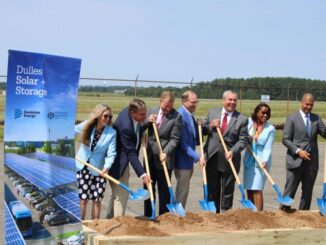
Newly empowered Virginia Democrats are pushing legislation this session that would elevate the role of customers and private developers in meeting the state’s clean energy targets.
A chief aim of the ARC bill — shorthand for Affordable, Reliable and Competitive — is to significantly expand the amount of power generated by less expensive, third-party solar and onshore wind projects in the service territories of both Dominion Power and Appalachian Power.
After legislators green-lighted the bold Virginia Clean Economy Act (VCEA) in 2020, regulators capped those types of projects at 35% of an investor-owned utility’s renewable energy portfolio.
Backers of the ARC legislation, House Bill 638 and Senate Bill 230, are calling for that 35% to act as a floor rather than a ceiling.
“We know the market can support at least 35%,” said Nate Benforado, senior attorney with the Southern Environmental Law Center. “We’re not saying the new target should be 100%. Whatever the number is, it’s best left to the discretion of the State Corporation Commission.”
Benforado’s organization collaborated with policy specialists at organizations including Advanced Energy United and the Sierra Club to shape the ARC legislation. They expect the proposal — with its emphasis on increasing market competition and lowering costs — will attract Republican supporters on its way through the General Assembly.
“This is one of those issues that is bipartisan,” he said about adjusting the existing statutory framework to escalate growth of renewables.
Briefly, the VCEA requires Dominion to incrementally meet a goal of 100% clean energy generation by 2045. Targets for 2025 and 2035 are 26% and 59%, respectively. Appalachian Power is supposed to follow suit by 2050.
Del. Rip Sullivan, a Fairfax County Democrat, is the patron of HB 638, while Sen. Ghazala Hashmi, a Democrat representing the Richmond region, is sponsoring the upper chamber version.
Just days after the legislative session convened on Jan. 10, Sullivan told attendees at a Virginia Grassroots Coalition online gathering that he was reluctant to attempt to tweak the VCEA until Democrats again regained majorities in both chambers.
That happened during the November election when Democrats held on to a slim majority in the Senate and flipped the House back to their control. Still, narrow vote margins mean they don’t have the supermajorities necessary to override vetoes or enact new laws that Republican Gov. Glenn Youngkin opposes.
Sullivan’s bill would also require the two large utilities to allow a fivefold increase in the percentage of distributed energy generated by small-scale solar and solar storage projects.
Solar installers are on the verge of exceeding the 1% renewable portfolio limit included in the VCEA because of customer demand for closer-to-home energy.
Bumping that upward to 5% is an incentive to let Virginia unlock the lowest-cost path to clean energy because it veers away from a utility-only approach, said Robin Dutta, acting executive director of the Chesapeake Solar & Storage Association.
His organization represents renewable energy developers in Virginia, Maryland, Delaware and the District of Columbia.
“There’s a huge climate argument for distributed generation,” Dutta said. “By lowering peak (energy) demand as much as possible, utilities don’t have to build out the grid with transmission lines and other infrastructure.”
The legislation would allow local, small-scale projects — which include rooftop solar, community solar and related storage — to be as large as 3 megawatts. That triples the current 1 MW cap.
Inviting the private sector to play a larger role not only drives technical innovation, but also lets non-utility entities and regular ratepayers be armed with their own power generation, Dutta said.
He praised Sullivan’s bill for folding in a pair of renewable stalwarts — third-party-owned solar projects and distributed energy — that green the grid and protect affordability for ratepayers.
“Those two pieces move the ball forward in two different ways,” Dutta said. “And that leads to a more equitable clean energy transition for ratepayers.”
One advantage of distributed generation is that solar panels aren’t covering acres of farmland, Benforado said. Instead, projects are sited near the people using the renewable energy, which avoids costly transmission and distribution upgrades.
Despite industry enthusiasm, Dominion Energy has a “number of concerns with the legislation” and is “working with the sponsor to hopefully address some of them,” utility spokesman Aaron Ruby told the Energy News Network.
The utility’s most pressing issue revolves around raising the distributed solar carve-out. Dominion claims that boosting it to 5% would require the utility to buy renewable energy credits from roughly 3,700 megawatts of distributed solar projects by 2048.
That is “completely unrealistic,” Ruby said, adding that adhering to the increase would cost Dominion about $260 million in penalties annually for being out of compliance with the incremental renewable energy goals laid out in the VCEA.
Ruby explained that Dominion has lowered customer electricity rates significantly and is more than a year ahead of schedule on meeting its renewable energy requirements.
“This legislation heads in the opposite direction on both scores,” he said. “You’ve heard the old saying, ‘If it ain’t broke, don’t fix it.’ I’d go even further. If it’s working, don’t break it.”
Third-party solar developers in Virginia — and elsewhere — usually engage in a mutually beneficial arrangement known as a power purchase agreement, or PPA for short, to help customers meet sustainability goals.
Generally, those deals allow the builder to install, own and operate the energy system on land the customer owns. The customer receives stable, often low-cost electricity with no upfront cost for a predetermined length of time, which enables the owner to take advantage of tax credits and earn income from the sale of electricity.
Environmental advocates maintain that solar projects built, operated and maintained by third parties are less expensive than those coordinated by utilities. For one, utilities receive a return on equity for capital expenditures and project costs are then passed on to ratepayers.
However, third-party builders are not only competing for business but investing their own capital, which means they assume all financial risks. That alone is incentive enough to deliver a successful project at a reasonable cost.
“With the Clean Economy Act, we have a path and a structure to improve the affordability of this transition to clean energy,” the SELC’s Benforado said. “We don’t want to see lower-cost options for customers dismissed because of a 35 percent cap.”
He pointed to testimony presented last January to utility regulators by Gregory Abbott on behalf of Appalachian Voices, an environmental nonprofit. Abbott, who had recently retired from the SCC after 24 years in the commission’s Division of Public Utility Regulation, was commenting on a case involving Dominion’s renewable energy portfolio.
Abbott stated that third-party-owned solar projects are a more affordable and “attractive option for captive customers” because of lower risks associated with performance and project development
Abbott also noted that Dominion has consistently left lower-cost, third-party solar projects out of its renewable energy mix because of its interpretation of 35% as an exact number instead of a suggestion.
On the Senate side, the bill has been referred to the full Labor and Commerce Committee. Over in the House, it was in front of a Labor and Commerce subcommittee as of Jan. 16.
“Virginia’s curve is headed up when it comes to renewables and clean energy,” said Sullivan, the House sponsor. “Despite what you may be hearing from some quarters, we can and should be on track to meet our goals. Having said that, we need to do better, we need to do it faster and we need to do more.”



